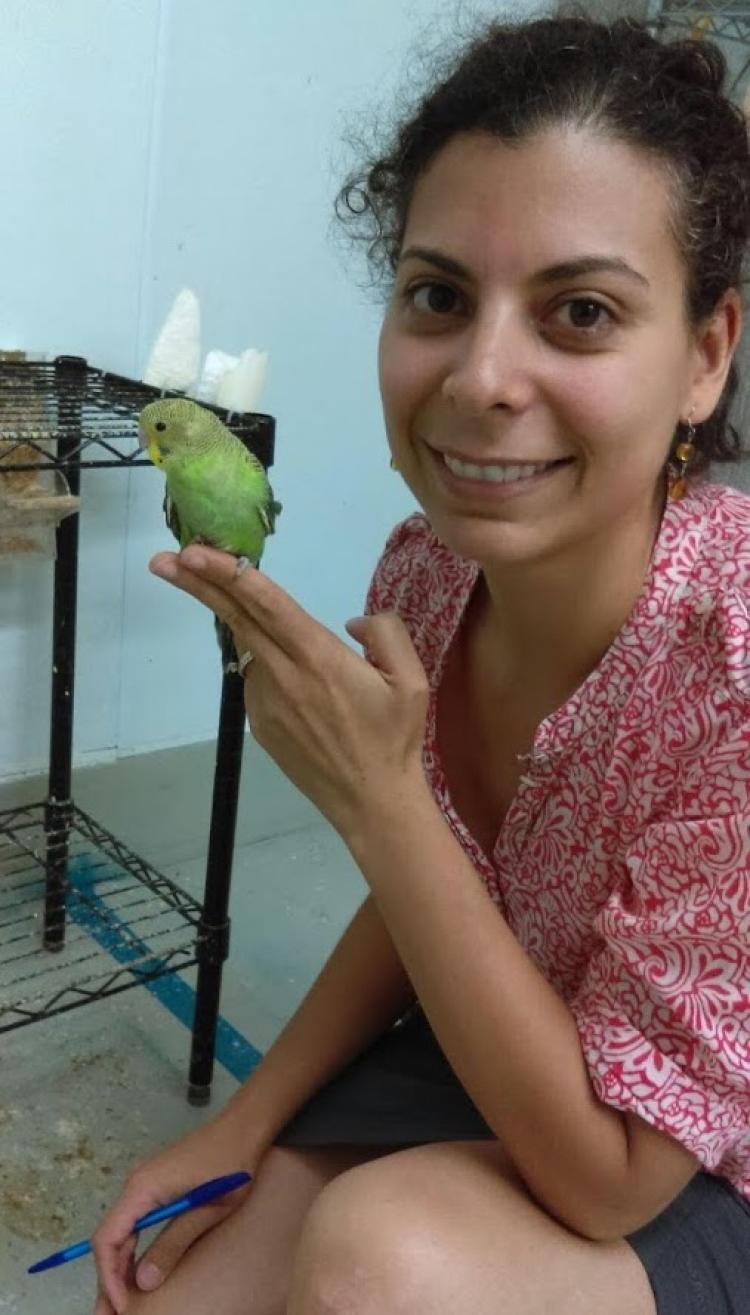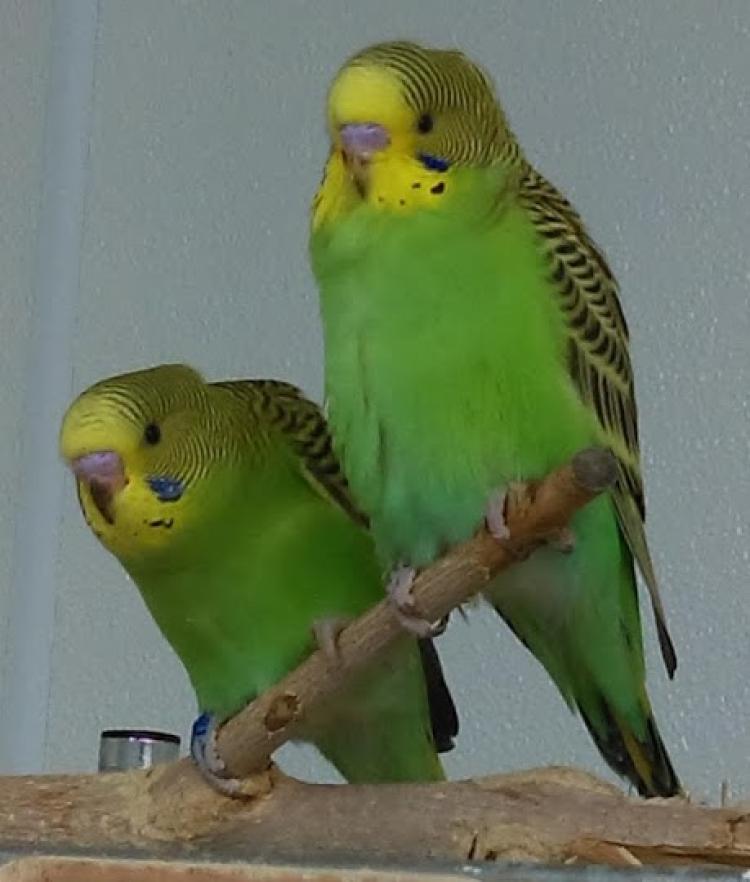Behavioral ecologist finds parakeet’s intelligence helps in reproduction
New research from CU Boulder sheds light on the cognitive functions of male ‘green parakeets’ or budgerigars
On PetSmart’s website and in stores, the vibrant green, yellow, blue and white budgerigar, an Australian grassland bird, is listed as a “Green Parakeets” and is avaliable for purchase for $39.99. The “parakeets” are known for their intelligence and are even able to mimic human speech, but that intelligence might serve an even more important function: reproduction and pair bonds, according to a new study by a researcher at the University of Colorado Boulder.

At the top of the page: Angela Medina-García holds a budgerigar in an enclosure. Above: Medina-García poses with a budgerigar at the Wright Behavior Lab. All images provided by Angela Medina-García.
This new study in Scientific Reports, titled “An integrative measure of cognitive performance, but not individual task performance is linked to male reproductive output in budgerigars,” found that female budgerigars choose males with high cognitive ablilities as their long term mates. Sexual selection varies in avian species, their physical condition may be prioritized for example. However, when female budgerigars choose their mates, a male’s cognitive performance is taken into consideration. Her research reveals new knowledge on a common pet and their cognitive abilities, which are not visible walking through the local PetSmart.
“How do we assess intelligence?” Angela Medina-García, a postdoctoral fellow at CU Boulder, asked. “There are many aspects of intelligence. I have always been very interested in female preferences and sexual selection. It’s this whole story of what’s involved in the decision of choosing a mate and what are the females looking at?”
To analyze the aspects of intelligence and female preferences, Medina-García completed a thorough assessment of male budgerigars’ cognition. She did this by assigning 30 male budgerigars to four tasks that focused on problem solving, detour reaching, seed discrimination and spatial memory. After the males were tested on their cognitive performances, Medina-García took note of 15 females’ mating choice processes—social pairing, extra-pair mating and continued reproductive investment—to see if the females chose to mate with more intelligent males.
Before integrating the males with the females, the male budgerigars executed the four cognitive tasks. Each task reflected a different cognitive ability and the budgerigar’s performance of each task was calculated into a total composite cognitive score. She developed a scoring system on a scale of one to four, four being the highest. If the male did not participate in the task, he would receive a zero. After performing the task, the male would be given a score and the male’s score could range from zero to 16.
Once the males received their score, the females joined the males to begin the mating choice processes.
“The one novelty of my study is that I looked at male or female preferences in a multi-stage framework. What that means is that for a species that is socially monogamous, they do form stable pair bonds, and some may last a lifetime,” Medina-García said. “However, they are not genetically monogamous in the sense that, once they’re paired, they look for matings with other birds outside the pair bond (i.e. extra-pair mates).”
In the first stage of social pairing, the budgerigars were split into groups of nine (six males and three females, five groups total). Between nine and 76 days, 12 males formed stable pair bonds and the other 18 males remained unpaired. At the end of the first stage Medina-García concluded that females do not choose social mates based on cognitive performance.
To test the second stage of pairing, 45 adults (30 males and 15 females) further mingled in an indoor aviary with 21 wooden nest boxes for six months while the nests were monitored daily. Medina-García used molecular paternal analysis to determine which males produced the most offspring. She found that males who performed well in the cognitive tasks sired more offspring.

Two budgerigars sit on a wooden perch.
“Based on things that allow them to assess the quality of their mates quickly, one thing might be the warble song (the song produced by male budgerigars), and that’s why we didn’t see that the cognitive score play a major role in the initial choice (first stage), but then the female spans one, two breeding seasons with this male, and there’s plenty of opportunities for her to evaluate how good their mates are or how they solve cognitively demanding situations” Medina-García said.“ At this stage is when we see, in my study, that the cognitive score did play a role in female mate choice.”
Medina-García’s experiments were conducted at New Mexico State University in the biology department. She began the budgerigar project at New Mexico State as a PhD student and later completed the publication process as a National Science Foundation postdoctoral fellow in Rebecca Safran’s lab at CU Boulder. Her advisor on the project was Timothy Wright, a professor in biology at New Mexico State.
“I think the fundamental result is really interesting that females do seem to care about cognitive abilities in males,” Wright said. “Like all good science, it leads to some very interesting follow up questions: do males care about the cognitive abilities of females? We didn’t test females at all. We had to start somewhere, and since sexual selection typically operates more strongly in males than females, we thought that would be the best place to start.”
Wright noted Medina-García’s perseverance through the entirety of the project, which reveals new information on this common bird.
“I think my study reveals a lot of things we didn’t know about budgies,” she said. “I feel like I’ve opened the door to do even more research on, not just the budgies, but trying to understand the process of mate choice in animals.”

